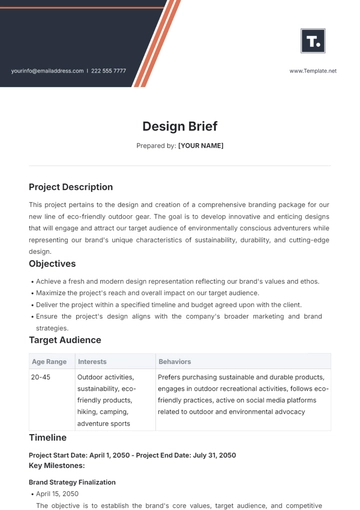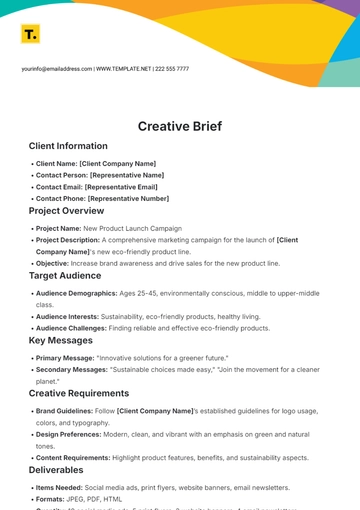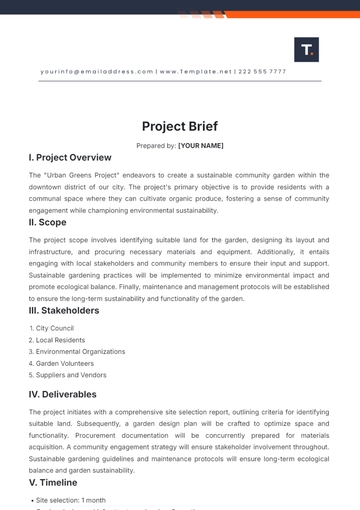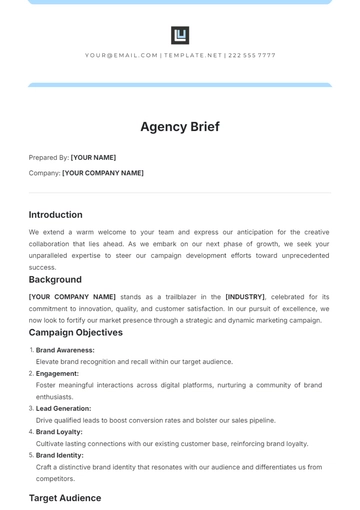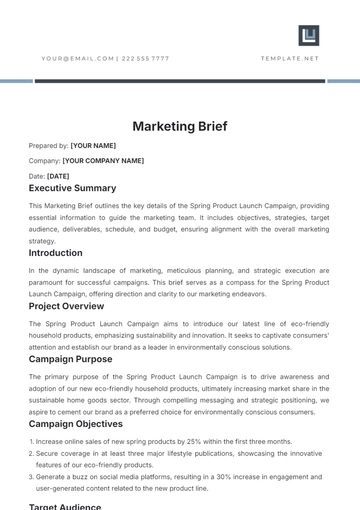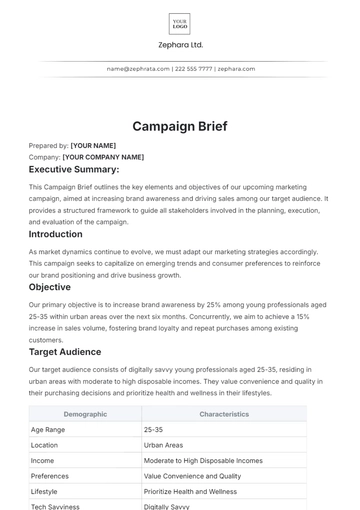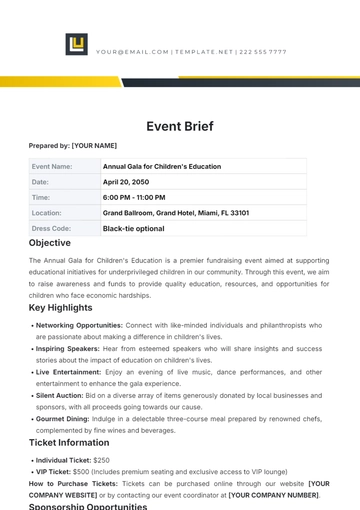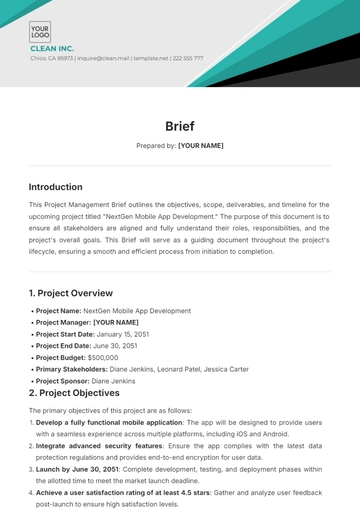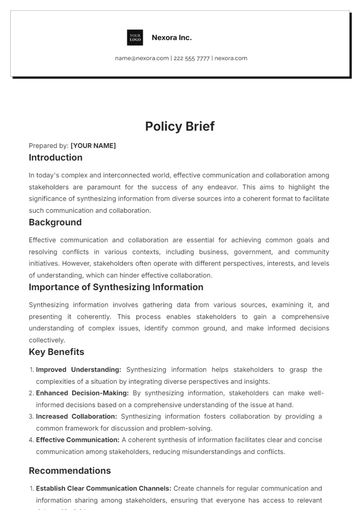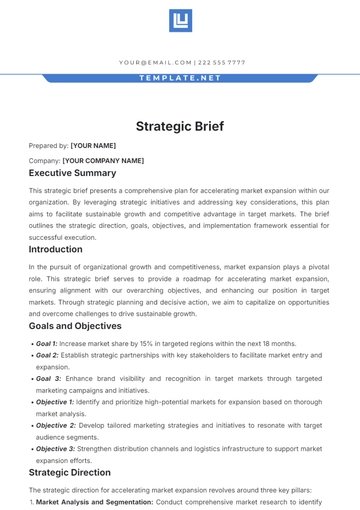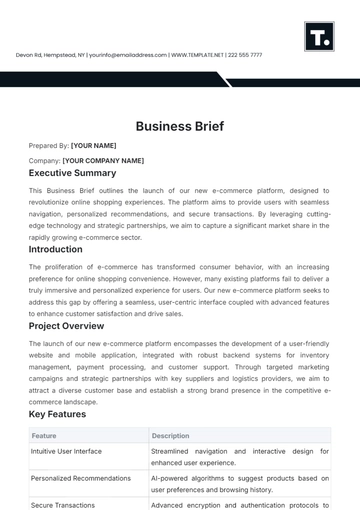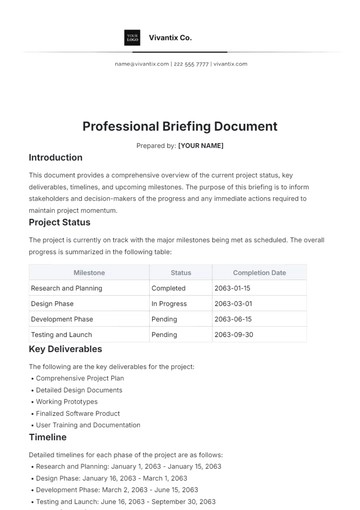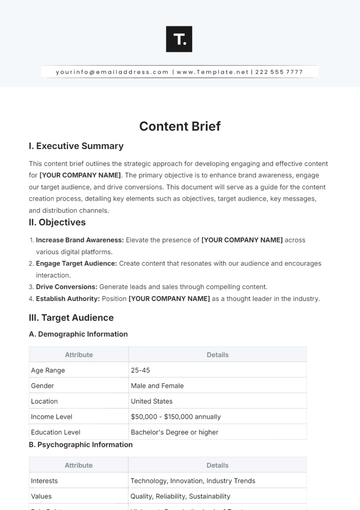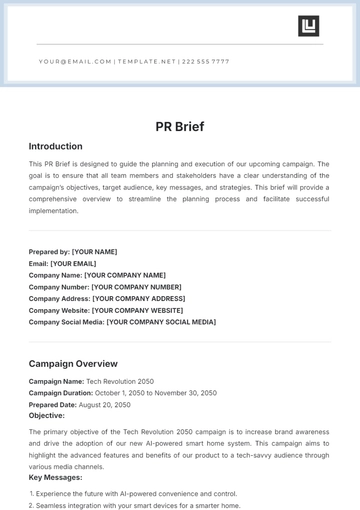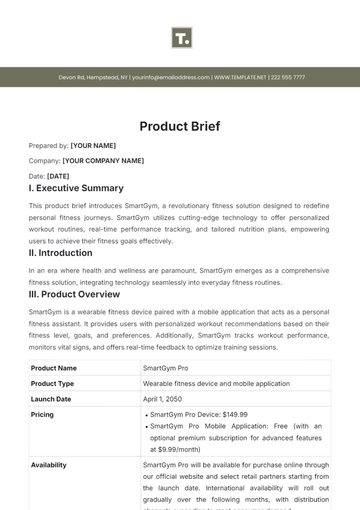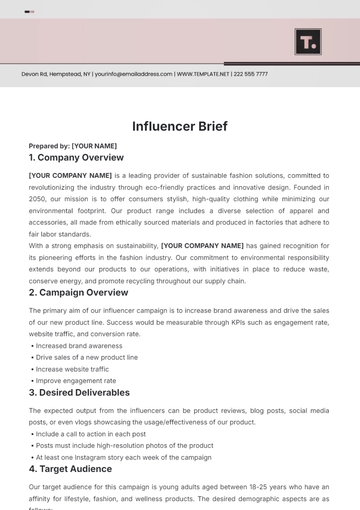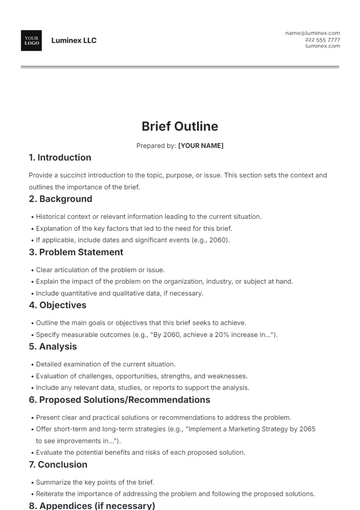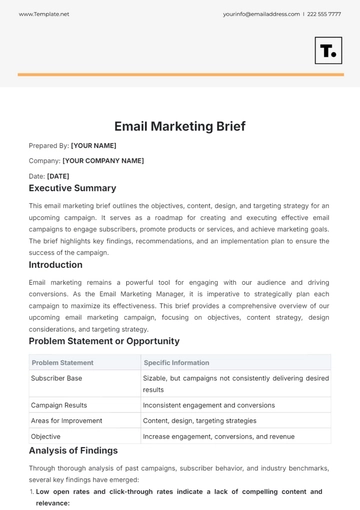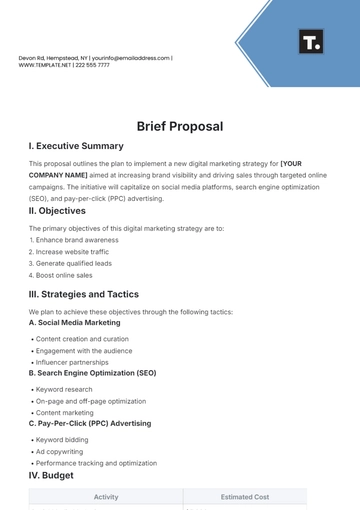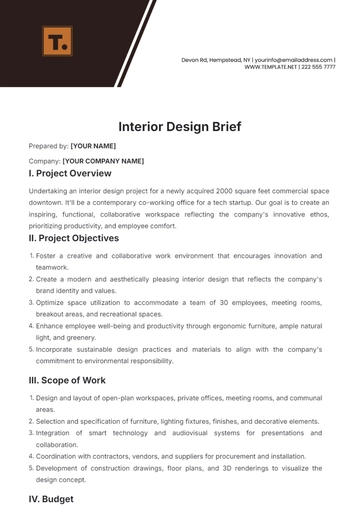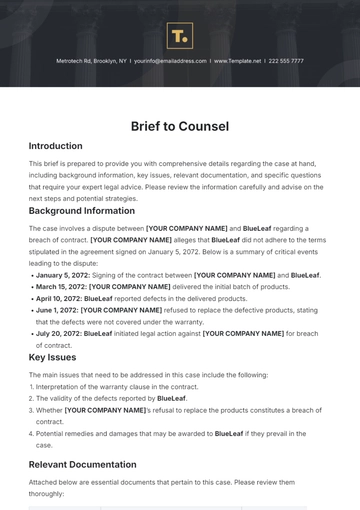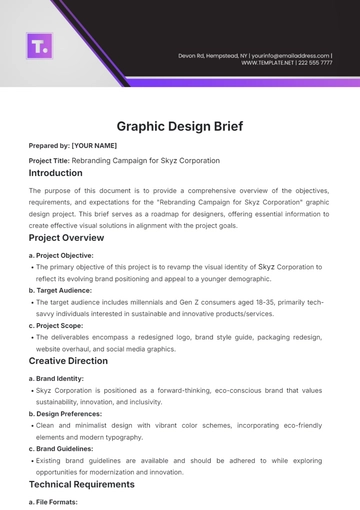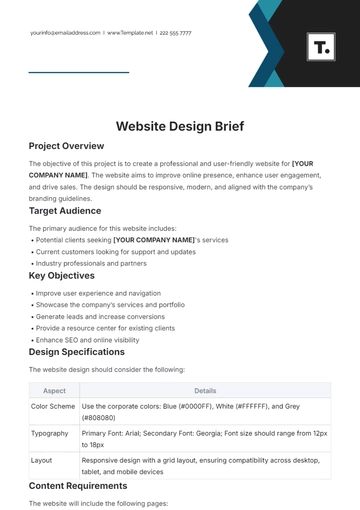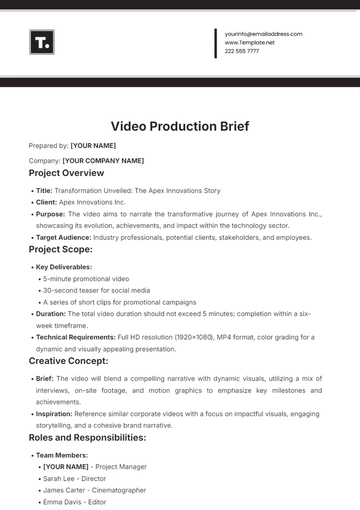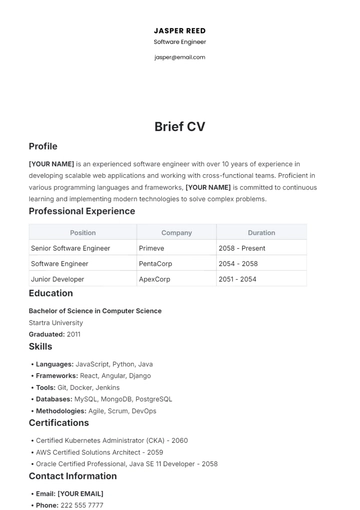Free Business Process Brief

Prepared By: [YOUR NAME]
Company: [YOUR COMPANY NAME]
Introduction
This Brief aims to provide a quick yet comprehensive overview of a selected business process. Understanding these processes aids in the optimization and enhancement of day-to-day operations, ultimately contributing to the overall success and growth of [YOUR COMPANY NAME].
Purpose of the Brief
Objectives of the Business Process
Key Steps Involved in the Process
Roles and Responsibilities
Brief Purpose
The purpose of this document is to provide all stakeholders with a clear understanding of the chosen business process and its importance within the company's operational framework.
Process Objectives
Objective | Description |
|---|---|
Efficiency | Aims to minimize resources or time needed for process completion |
Quality | Improving the overall quality and outcome of the process |
Transparency | Ensuring all stakeholders understand and are aware of the process |
Compliance | Aligning the process with industry and regulatory standards |
Key Steps Involved
The execution of the [Process Name] encompasses several key stages, each critical for achieving successful outcomes. Below is a detailed breakdown of these stages, along with associated risks and dependencies:
Initiation Stage:
This stage involves the identification and definition of the [Process Name] project.
Key activities include defining project objectives, scope, and stakeholders' roles.
Risks: Lack of clarity in project objectives, and inadequate stakeholder engagement.
Dependencies: Availability of resources, approval of project charter.
Planning Stage:
During this stage, detailed planning and scheduling of project activities occur.
Activities include developing a project plan, resource allocation, and risk assessment.
Risks: Inaccurate estimation of resources, failure to identify potential risks.
Dependencies: Access to necessary tools and technology, availability of skilled personnel.
Execution Stage:
This stage involves the actual implementation of the [Process Name] project plan.
Activities include carrying out defined tasks, monitoring progress, and addressing issues.
Risks: Delays in task completion, resource constraints, unexpected changes in requirements.
Dependencies: Clear communication channels, and adherence to project schedule.
Monitoring Stage:
Continuous monitoring of project progress and performance occurs during this stage.
Activities include tracking key metrics, identifying deviations, and taking corrective actions.
Risks: Inadequate monitoring leading to project drift, and failure to address emerging issues promptly.
Dependencies: Availability of monitoring tools, and regular status updates from team members.
Closure Stage:
The final stage involves formalizing project completion and delivering outcomes.
Activities include conducting project reviews, documenting lessons learned, and transitioning deliverables.
Risks: Incomplete documentation, failure to capture lessons learned.
Dependencies: Stakeholder acceptance of project deliverables, and handover to relevant parties.
Roles and Responsibilities
Identifying key roles and responsibilities is essential for effective execution and coordination of the [Process Name]. This section outlines the individuals or teams involved and their specific tasks or functions.
Process Owner:
Responsible for overall governance and oversight of the [Process Name].
Ensures alignment with organizational objectives and strategic goals.
Collaborates with stakeholders to identify areas for improvement and implement necessary changes.
Process Manager:
Oversees day-to-day execution of the [Process Name].
Develops and maintains process documentation, including procedures and guidelines.
Monitors performance metrics and identifies opportunities for optimization.
Team Members:
Participate actively in executing the key steps of the [Process Name].
Follow established procedures and guidelines to ensure consistency and quality.
Provide feedback and suggestions for process improvement.
Stakeholders:
Provide input and requirements for the [Process Name].
Review and approve changes to the process as necessary.
Ensure alignment with organizational goals and priorities.
Support Teams:
Provide technical or administrative support as required during the execution of the [Process Name].
Assist in troubleshooting issues and resolving challenges encountered during the process.
Quality Assurance/Control:
Ensure compliance with regulatory requirements and internal standards.
Conduct audits and reviews to identify non-conformities and areas for improvement.
Implement corrective and preventive actions to address quality issues.
Training and Development:
Provide training and resources to team members involved in executing the [Process Name].
Ensure understanding of roles, responsibilities, and procedures related to the process.
Facilitate continuous learning and skill development to enhance process proficiency.
Communication Liaison:
Facilitate communication among stakeholders, team members, and support teams.
Distribute relevant updates, notifications, and changes related to the [Process Name].
Address inquiries and concerns to ensure clarity and alignment.
Performance Analyst:
Analyze performance metrics and data related to the [Process Name].
Identify trends, patterns, and areas for improvement based on performance indicators.
Provide insights and recommendations to enhance efficiency and effectiveness.
Performance Indicators and Measurement
To gauge the effectiveness of the [Process Name] and track its performance over time, the following key performance indicators (KPIs) and metrics have been identified:
Cycle Time: The average time taken to complete the entire [Process Name] from initiation to closure. This metric helps assess the efficiency of the process.
Accuracy Rate: The percentage of tasks completed accurately without errors or rework. This KPI indicates the reliability and quality of the process outputs.
Completion Rate: The percentage of tasks or steps completed within the defined timeframe. This metric reflects the timeliness and adherence to deadlines within the process.
Cost per Process: The total cost incurred in executing the [Process Name], including labor, materials, and overhead expenses. Monitoring this metric helps in identifying opportunities for cost optimization.
Customer Satisfaction Score (CSAT): Feedback gathered from internal or external stakeholders regarding their satisfaction with the process outcomes and service delivery. This KPI provides insights into meeting customer expectations and needs.
Error Rate: The frequency of errors or deviations encountered during the execution of the process. Monitoring this metric helps identify areas requiring corrective actions and process improvements.
Employee Engagement: Measures the level of employee involvement, motivation, and satisfaction in executing the [Process Name]. High employee engagement correlates with improved process performance and organizational effectiveness.
Process Efficiency Ratio: The ratio of output to input, indicating how effectively resources are utilized in executing the process. Improving this ratio leads to higher productivity and cost-effectiveness.
Compliance Rate: The extent to which the process adheres to regulatory requirements, industry standards, and internal policies. Maintaining a high compliance rate ensures legal and operational integrity.
Lead Time: The elapsed time between the initiation of a task or process and its completion. Monitoring lead time helps in identifying bottlenecks and streamlining process flow.
- 100% Customizable, free editor
- Access 1 Million+ Templates, photo’s & graphics
- Download or share as a template
- Click and replace photos, graphics, text, backgrounds
- Resize, crop, AI write & more
- Access advanced editor
Introducing the Business Process Brief Template from Template.net: your ultimate resource for streamlined operations. This customizable and editable template simplifies business process documentation, ensuring accuracy and efficiency. With our Ai Editor Tool, effortlessly tailor every detail to fit your organization's needs. Simplify process mapping and elevate your operations with ease, exclusively on Template.net.
